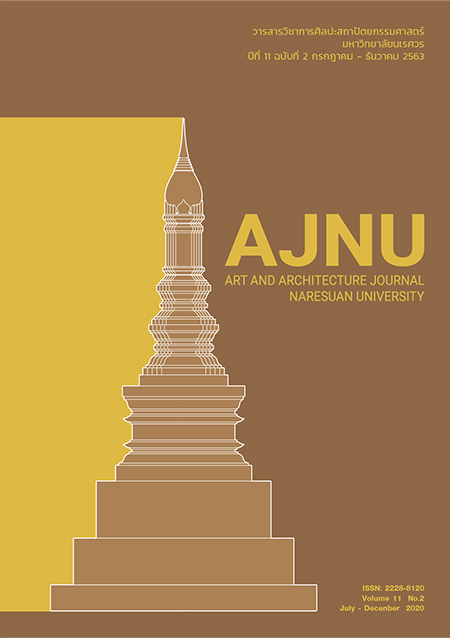The development of sugarcane leaf fibers for the production of apparel’s accessories
Main Article Content
Abstract
This research aims to 1) Develop the sugarcane leaf fibers by immersion bio-fermentation water method 2) Produce the handicraft sugarcane leaf yarn by using mixed cocoon silk and 3) Industrial standard test of sugar cane leaf woven to design and apparel products. The research found that the concentration of bio-fermented water were 80 percent by 50 liters of capacity per fresh sugarcane leaf to tear off the core 10 kilograms for 4 months in immersion fermentation time were up 45 percent yield. Transform the fiber by boiling with 10 liters of water mixed with 0.2 grams of sodium hydroxide at 100 degrees Celsius for an hour to yield 55.55 percent. When using 20, 40, 60 and 80 percent cocoon fibers mixed with sugarcane leaf fibers. Then use the rim to turn it into a fluff before hitting thread found that cocoon fibers were mixed in 4 qualities of sugarcane leaf products. The industrial standards testing of sugarcane leaf woven yarn as the following results were maximum tear resistance 32.96 were formula 3 (60: 40). The pulling forces of yarn according to weft thread were 4.73 Newton. The speeds of the stretch were 34.76 mm. using the formula 2 (40: 60). The average maximum thicknesses were 1.291 mm. using formula 4 (80: 20). The bend of the weft thread were 5.50 centimeters using formula 4 (80: 20) and the average highest moisture were 8.22 percent, which were the fourth piece (80: 20). When design focused on using the apparel products, it was found that sugarcane leaf woven yarn could produce bags, hats and shoes. They were shapely, beautiful and strong for use.
Article Details
References
จรรยาวรรณ จรรยาธรรม และประทับใจ สิกขา. (2555). การพัฒนาเส้นใยของต้นจากเพื่อใช้ในการออกแบบผลิตภัณฑ์.วารสารวิชาการ ศิลปะสถาปัตยกรรมศาสตร์ มหาวิทยาลัยนเรศวร, 3(1), 94-104
พิทักษ์ อุปัญญ์, จันทร์เพ็ญ อุปัญญ์, และ ธนเดช แป้นโพธิ์กลาง. (2554). การพัฒนาผลิตภัณฑ์เส้นใยลูกตาลในเชิงอุตสาหกรรมสิ่งทอ. (รายงานการวิจัย). กรุงเทพฯ: สำนักงานคณะกรรมการวิจัยแห่งชาติ.
สาคร ชลสาคร. (2558). เทคโนโลยีการแยกสกัดใยจากพืช. กรุงเทพฯ: สถาบันพัฒนาอุตสาหกรรมสิ่งทอ.
สมประสงค์ ภาษาต่างประเทศ. (2560). เทคโนโลยี และ นวัตกรรมเพื่อการพัฒนาเส้นใยธรรมชาติจากพืช เล่มที่ 3 การปั่นด้ายใยสั้นชนิดยาวจากพืช. กรุงเทพฯ: สถาบันพัฒนาอุตสาหกรรมสิ่งทอ.
สถาบันพัฒนาสิ่งทอ. (2561). ทิศทางเส้นใยธรรมชาติ...สู่อุตสาหกรรม 4.0. สืบค้นเมื่อ 18 มิถุนายน 2561, จาก http://www.thaitextile.org/index.php/blog/2016/10/2016-10-04
เสาวณีย์ อารีจงเจริญ, นฤพน ไพศาลตันติวงศ์, รัตพล มงคลรัตนาสิทธิ์, และสาคร ชลสาคร. (2556). การพัฒนาผลิตภัณฑ์สิ่งทอจากเส้นใยตะไคร้. (รายงานการวิจัย). กรุงเทพฯ: มหาวิทยาลัยเทคโนโลยีราชมงคลพระนคร.
ศูนย์เทคโนโลยีโลหะและวัสดุแห่งชาติ. (2561). ความรู้และเทคโนโลยีสิ่งทอ. สืบค้นเมื่อ 15 มิถุนายน 2561, จาก https://www2.mtec.or.th/th/research/textile/textile_sci.html
ศศิประภา รัตนดิลก ณ ภูเก็ต. (2558). เทคโนโลยีการผลิตสิ่งทอจากใยพืช เล่มที่ 3 เทคโนโลยีการเตรียมเยื่อเซลลูโลส และการปั่นใยเซลลูโลสประดิษฐ์. กรุงเทพฯ: สถาบันพัฒนาอุตสาหกรรมสิ่งทอ.
TTIS Textile Digest. (2015). 23(195) (November-December), 28-30


